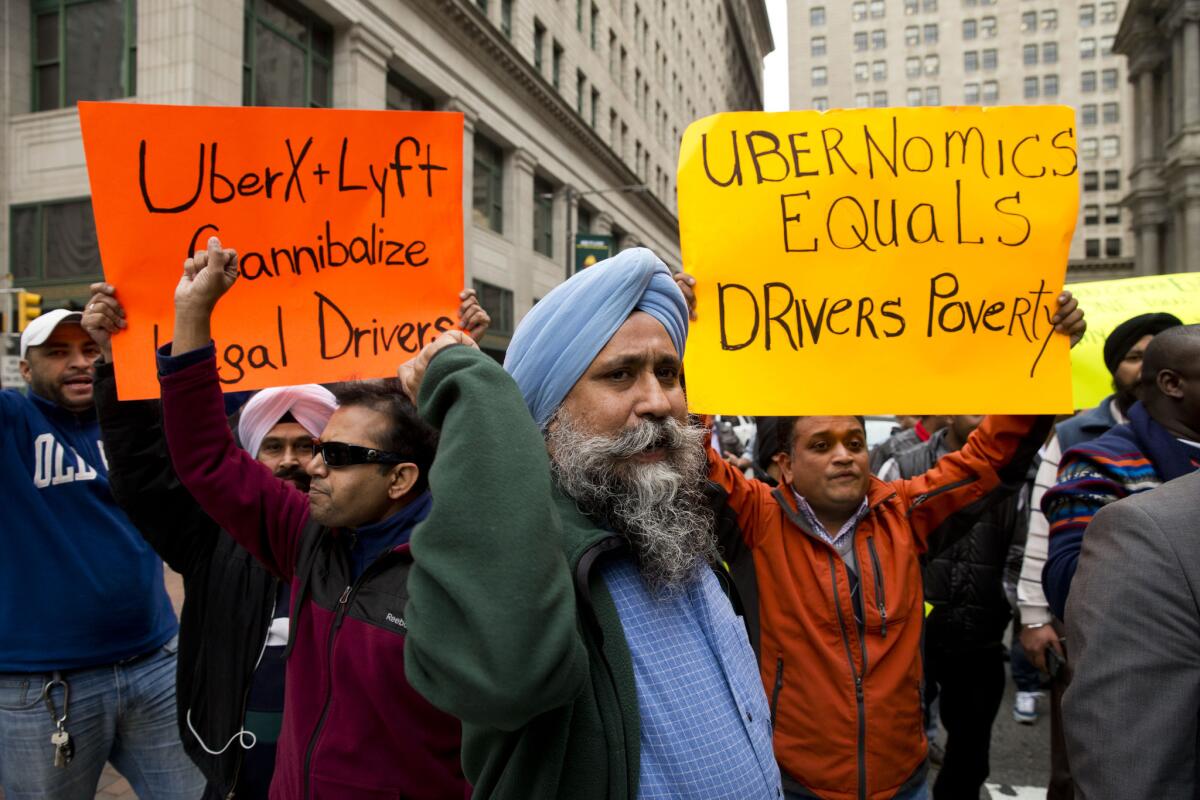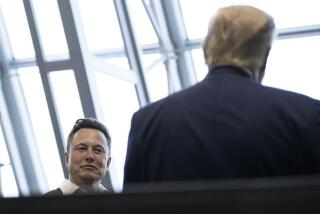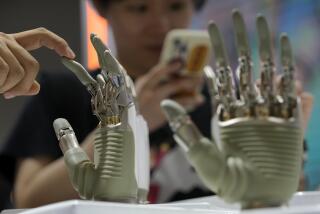Column: How the Uberization of work is rooted in the cult of ‘shareholder value’

Ubernomics: Who benefits? Taxi and Uber drivers protest the ride-hailing services Uber X and Lyft last month in Philadelphia.
It’s getting easier to tote up the damage from the Uberization of the U.S. economy -- especially by Uber itself. The victims include taxi drivers and owners, whose business is being cannibalized, and Uber drivers themselves, who struggle against competition from other Uber drivers, the cost of their own gas and maintenance, and rate-cutting by Uber.
The biggest casualty may be the cherished notion of the big corporation and the valiant entrepreneur as “job creators.” As Jerry Davis, a professor of management and sociology at the University of Michigan, observes in a wide-ranging piece published just before New Year’s by the Brookings Institution, they’re not. And economic policy will be much better off if we stop thinking they are.
Creating shareholder value and creating good jobs are largely incompatible. Corporations are ‘job creators’ only as a last resort.
— Jerry Davis, University of Michigan
The corporate trend has been to shift employment “from the career, to the job, to the task,” Davis writes -- from long-term corporate employment, to outsourcing of certain functions, to the labor-on-demand paradigm of Uber. “Creating shareholder value and creating good jobs are largely incompatible,” he writes. “Corporations are ‘job creators’ only as a last resort.”
The same goes for entrepreneurial start-ups: The idea that these are engines of job creation is based on the record of Amazon and Google, but they’re atypical. In Davis’ database of IPOs since 2001, the firm with the biggest growth in employment after its initial public offering was Brookdale Senior Living , which expanded to 82,000 workers from 16,000 in the nine years after its 2005 IPO. But almost all that growth came from its acquisition of senior care homes in the process of consolidating a fragmented industry.
Davis traces the birth of Uberization to the cult of “shareholder value,” which is far less traditional than its proponents choose to imagine. From the 1930s through World War II and into the postwar period, he observes, “American corporations became model long-term employers.” The corporate sector “served a critical function in providing pathways to economic security and mobility.... A corporate job was a good job, with a chance to move up in the world.”
In 1949, management guru Peter Drucker declared that the corporation’s responsibility was to serve employees, customers and only then stockholders, who were entitled only to “a maximum return equivalent to a risk premium. The remaining profit stays in the enterprise, is paid out in higher wages, or is passed on to the consumer in the form of lower prices.”
What altered this widely accepted paradigm? Two things. First, the emblematic corporations of the day became fat, lazy and inefficient. Some turned into conglomerates, with no organizing rationale except to get bigger and more diverse.
One of the biggest conglomerates was Gulf & Western, cobbled together by Charles Bluhdorn from businesses that “literally ranged from A to Z,” as an Associated Press writer remarked, “from auto parts to zinc mining.” But the whole was worth less than the parts -- after Bluhdorn’s death in 1983, Gulf & Western’s share price soared as his successor began to sell off the pieces.
The second change was technological. The Internet made it easier for big companies to outsource work, especially manufacturing, that they had long kept in-house, in part by allowing them to detect the real difference in making-versus-buying inputs.
By the turn of the 21st century, a company’s overall market value was no longer tied to its payroll. In 1962, the largest corporation by market capitalization was AT&T, with 564,000 employees; in 2012, it was Apple, with 76,000 employees. Big employers are now typically retailers and food service firms, which employ armies of part-time and low-wage workers; the largest employer among big companies today is retailer Wal-Mart, with 2.2 million workers.
Shifting inputs from built-in-house to built-outside and ordered just-in-time revolutionized manufacturing. The same trend is being followed with labor, rather than raw materials or parts. That’s Uberization -- the company doesn’t even outsource labor, it just orders workers at the moment they’re needed.
The problem is that human beings aren’t spare machine parts. They’re consumers whose spending is necessary to keep the economy moving, household creators with the need to sustain families and voters with a political interest in economic growth.
But our political structure hasn’t kept up. We’re still talking about corporations and entrepreneurs as “job creators,” and still assuming that they’ll be the chief providers not only of solid wages but long-term benefits such as healthcare and pensions.
Thus far, shareholders have been the major winners in the transforming of American work. That’s a growing driver of income inequality and not a sustainable model. But only recently, and still slowly, have labor regulators awakened to the fact that workers in the “gig economy” are being systematically shortchanged, as Steven Greenhouse has demonstrated with his superb reporting in the American Prospect.
The choices are few. Companies like Uber will have to be forced to accept traditional responsibilities for workers who actually are performing the work done by traditional employees, regardless of how the employer defines them. In some states, such as California, the first blows have been struck by labor regulators and judges. Seattle has taken steps to allow Uber drivers to unionize, which will help awaken the company to its responsibilities.
But society as a whole may also have to recognize that the responsibility of social welfare, whether healthcare or retirement, will have to be borne more by government, a trend that started as long ago as 1935 with Social Security, continued with Medicare in 1965 and proceeded with the government subsidies provided to insurance purchasers by the Affordable Care Act. If corporate employers and their shareholders are intent on shedding their traditional roles as bulwarks of the working person and the family in order to keep more wealth for themselves, there really is no other way to make them pay.
Keep up to date with Michael Hiltzik. Follow @hiltzikm on Twitter, see our Facebook page, or email michael.hiltzik@latimes.com.
More to Read
Inside the business of entertainment
The Wide Shot brings you news, analysis and insights on everything from streaming wars to production — and what it all means for the future.
You may occasionally receive promotional content from the Los Angeles Times.











